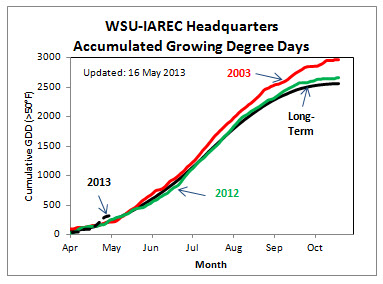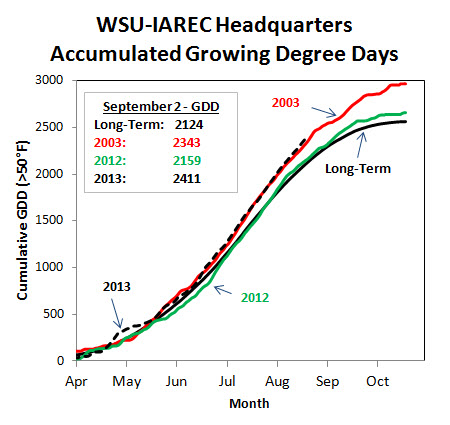**Click here to download the 2013 Combined Vintage Updates**
16 May 2013
By Michelle Moyer, Viticulture Extension Specialist, WSU-IAREC
Growing Degree Days
Whatever early-season heat was in past vintages, we have made up for it in 2013 (Figure 1). With temperatures already reaching above 90 °F, GDD accumulation for WSU-IAREC is currently at 330. To place this in perspective, we were at 245 at this time in 2012 and at 79 in 2011. This early-season heat has sped up vine development, with some of the warmer areas around the state already seeing early signs of bloom. Here at WSU-IAREC, we are about 10 days ahead of where we were last year, with bloom expected to arrive near the end of the month.
Precipitation
Unlike heat, precipitation in 2013 is well behind average (Figure 2). Keep in mind that severe water stress leading up to, and through bloom, can result in poor fruitset and cluster development. Since water management is critical during this period of vine development, make sure your irrigation strategies accurately reflect water demands in the vineyard. See: http://wine.wsu.edu/research-extension/irrigation/ for more information on water management in vineyards.
Nutrient Management
Just as water is important for proper fruit development, so is adequate vine nutrient status. Remember, however, that water is necessary for nutrient transport into the vine, highlighting the critical need for adequate water supply during bloom. Nutrient monitoring around bloom, and near véraison, are typically recommended. For more information on vine/vineyard nutrient monitoring, see: http://wine.wsu.edu/research-extension/plant-health/nutrition-and-soils/.
Critical Window for Disease Control
As we rapidly advance towards bloom, we are also rapidly approaching the critical window for powdery mildew disease control. Wine grape clusters are susceptible from cluster emergence until around 3-4 weeks post fruitset. Read up on powdery mildew management at: http://wine.wsu.edu/research-extension/plant-health/grape-diseases/. Also, do not forget proper fungicide rotation (based on FRAC groups), to follow best spray practices (changing nozzles, not driving too fast, using appropriate water volume), and to not stretch spray intervals during the critical window.

Make your own GDD chart for the AgWeatherNet station nearest you at: http://weather.wsu.edu

Make your own precipitation chart for the AgWeatherNet station nearest you at: http://weather.wsu.edu
22 May 2013
By Michelle Moyer, Viticulture Extension Specialist, WSU-IAREC
In the last vintage update, we had a short blurb on the “critical window” for powdery mildew management. As vineyards across the state advanced into bloom this week, so did the cool, wet weather. This is creating the ideal situation for disease outbreak: conducive weather at a time of peak plant susceptibility. Below is a list of three key factors in the design and implementation of a successful disease management program. In addition to the below, read up on the powdery mildew fungus and its specific management at: http://wine.wsu.edu/research-extension/plant-health/grape-diseases/.
Fungicide Resistance Management
More appropriately titled “Sustainable Fungicide Use”, fungicide resistance management is critical for the longevity of our industry. The useful lifespan of any pesticide is dependent on its efficacy, and inappropriate use of that product will deteriorate (or outright eliminate) its usefulness in the future.
Many people view managing fungicide resistance development as the rotation of their “big-gun” products, and they base this rotation solely on alternating fungicides of different trade names. Unfortunately, this doesn’t work, as many fungicide products, while named differently, are actually closely related. True fungicide rotation is based on alternating fungicides with different FRAC (Fungicide Resistance Action Committee) codes. FRAC codes are assigned to fungicides based on their modes of action (how they kill/suppress a fungus). For example, DMIs (e.g., Rally, Procure) are FRAC group 3 fungicides; QoIs/strobilurins (e.g., Sovran, Flint) are FRAC Group 11 fungicides; and some fungicides contain multiple FRAC groups (e.g., Pristine- FRAC 11 and 7; Quadris Top- FRAC 11 and 3). Clearly, knowing what the FRAC group(s) of your fungicides are is critical when designing a proper spray program.
Some general tips for the more commonly used FRAC groups (i.e., 3 and 11): While these products are typically highly effective at controlling powdery mildew, they are also highly prone to resistance development. There are limitations on their annual use: DMIs (or premixed products containing FRAC group 3 compounds) should not be applied more than 3x a season, and never more than 2 times in sequence; QoIs (or premixed products containing FRAC group 11 compounds) should not be applied more than 2-3x a season and never in sequence. While early use of synthetic fungicides might be warranted in locations with high PM pressure, be aware of your season-total application limit when using DMIs and QoIs, and consider tank-mixing with sulfur or oil to aid in resistance management.
Best Spray Practices
To improve the efficacy of your spray program, consider the following: (i) Have you calibrated your sprayer this year, and do you have a maintenance program for determining nozzle wear? Nozzles should be replaced on an annual basis. (ii) Do you really save time by driving faster? One of the best ways to improve your spray program is to slow down the tractor. Going too fast through a vineyard reduces spray penetration and coverage. (iii) What is your water volume? Remember, water is just a way to deliver the pesticide product to the plant—you can deliver the same 4 oz of a product over an acre in 30 gallons or 100 gallons of water. What is important is whether the product has adequate solubility in the volume of water you are using, whether you are using a piece of equipment designed to delivery your desired volume of water, and whether that volume of water is appropriate for the canopy size. If the canopy is small and a large volume of water is used, much of the water will run off the plant (and so will the product!). If the canopy is large and you use too small a water volume, then you will not get sufficient distribution of the product on the canopy. (iv) What are your spray intervals? When weather conditions are conducive for disease development, the shorter spray intervals indicated on the pesticide label are appropriate. Never stretch intervals beyond what is indicated on the label, especially during times of peak susceptibility of the plant. You are only leaving the plant unprotected from future infection.
What Do You Spray?
Early in the season, the best tools for disease management are those products with multiple modes of action and that have some eradication activity. Luckily for both organic and conventional grape disease management, these two tools are the same, and they are sulfur (flowable sulfurs are preferred for early season application) or narrow-range petroleum oils. If temperatures are cool and conditions are dry, intervals can be long after these first applications. However, if rains immediately follow application, consider wash-off potential when determining your intervals. BUT be careful when applying sulfur or oils, and do not rotate between the two at tight (<14 day) intervals, as you increase the risk of a phytotoxic response.
When entering the “critical window”, use the best available products for your management style. Please consult the fungicide table (Table 1) on page 26 of the 2013 Pest Management Guide for Grapes in Washington (EB0762) for a partial listing of available fungicides in Washington, and their efficacy as determined by fungicide trials conducted at WSU-IAREC in Prosser, WA.
28 June 2013
By Michelle Moyer, Viticulture Extension Specialist, WSU-IAREC
Rollercoaster Month
From hot to cold, and back to scorching hot, this vintage has been everything but “average.” Recent cool, rainy periods have created challenges both in disease and canopy management. The forecast triple-digit temperatures for this weekend and next week, however, should provide a welcome reprieve for both. Below is a quick snap-shot of general precipitation and temperature trends for the lower Yakima Valley, as well as information on disease and pest management.
Precipitation. The year started off with significantly below normal precipitation, but has quickly caught up, with areas receiving more than 1 inch of rain in the last couple of weeks (Figure 1). This added precipitation, along with cooler temperatures, has created some challenges. Higher-than-normal cap retention has been reported across the region (likely due to humidity and surface wetness), as well as excessive canopy growth. Repeated and prolonged rain events have made it challenging to get, and keep, sprays on the rapidly developing canopy.
Due to high cap retention and cool weather, vigilance to weather conditions in the fall is advised; excess debris in clusters during bloom, in additional to the associated weather conditions thus far, are prime for Botrytis cinerea colonization of the clusters. While this does not mean an actual infection occurred, or that you are guaranteed an outbreak of Botrytis bunch rot this fall, what it does mean is that the inoculum potential for Botrytis bunch rot is there, and if fall weather conditions are right, an outbreak could occur. Hot, dry fall conditions, however, will suppress that potential outbreak. More information on Botrytis bunch rot management can be found in Extension Publication #FS046e.

Growing Degree Days (GDD)
Even with cooler temperatures in mid-June, 2013 is still on par with typical growing degree day accumulation (Figure 2). Heat spikes in early May, followed by rainfall in late May and mid-June, have allowed sufficient, if not excessive, vine growth thus far for the vintage. While expected 100°F + weather on its way, GDD accumulation will significantly advance, well beyond those numbers seen in 2003, which was classified as a hot year. However, keep in mind that vines typically shut down at temperatures above 95°F, so that added heat may not add to advancement in vine development.

Pesticide Use Reminder
The following is an excellent reminder, distributed through the USDA Office of Pest Management Policy, to be fully aware of pesticide use, label requirements, and more importantly, understanding label warnings.
- Use of any pesticide in any way that is not consistent with label directions and precautions is illegal. It may also be ineffective and dangerous. The basic steps in reducing pesticide risks are:
- Choose the form of pesticide best suited to your target site and the pest you want to control:
- First, identify the problem correctly and then, choose the least-toxic pesticide that will achieve the results you want and be the least toxic to you and the environment.
- When the words “broad-spectrum” appear on the label, this means the product is effective against a broad range of pests. If the label says “selective,” the product is effective against one or a few pests.
- Choose the form of pesticide best suited to your target site and the pest you want to control:
- Read the label before buying the pesticide, read the label before mixing or using the pesticide each time, and read the label before storing or disposing of the pesticide.
- Determining the right amount to purchase and use: do not assume that using more pesticide than the label recommends will do a better job. It won’t.
- Find the signal word—either Danger, Warning, or Caution on the pesticide label. The signal word tells you how poisonous the product is to humans.
- Choose the form of pesticide (aerosol, dust, bait, or other) best suited to your target site and the pest you want to control. Certain formulations work better for some pests and/or some target areas than others.
- Using the product safely and correctly:
- Never apply pesticides outdoors on a windy day (winds higher than 10 mph).
- Wear protective clothing, don’t smoke or eat.
- Mix and apply only the amount you need.
- Watch for negative effects on wildlife (birds, butterflies, and bees) in and near treated areas. If you see any unusual behavior, stop using that pesticide, and contact EPA’s Pesticide Incident Response Officer.
- Store and dispose of pesticides properly.
- Follow all storage instructions on the pesticide label.
- Always store pesticides in their original containers, complete with labels that list ingredients, directions for use, and first aid steps in case of accidental poisoning.
- State and local laws regarding pesticide disposal may be stricter than the federal requirements on the label. Be sure to check with your state or local solid waste agency before disposing of your pesticide containers.
3 September 2013
By Michelle Moyer, Viticulture Extension Specialist, WSU-IAREC
Precipitation
Most of July and August were characterized by typical low rainfall (Figure 1). However, recent rain events, combined with forecast severe weather, are creating concern about fall fruit rots. Those conditions, coupled with increasing sugar accumulation in fruit, set the stage for potential outbreaks of Botrytis Bunch Rot (BBR).
In addition, typically-dry years often are noted for high levels of insect activity. Mealybug activity (and the production of honey dew), can increase the risk of BBR in your vineyards due to creating an attractive target for piercing and chewing insects. These will create the wounds necessary for Botrytis fungus infection, while precipitation events will create the appropriate humidity and leaf wetness necessary for successful infection.
Should these rain events be realized, it is important to remember that most products labeled for BBR control are protectants, meaning they must be on the vine prior to fungal infection. In addition, many boast 7-10 day pre-harvest intervals (PHI), so as harvest approaches, management options become increasingly few. Once and outbreak occurs in a vineyard, it cannot be eradicated short of removing whole clusters (by hand). The spread of the fungus within a cluster can be slowed, but that slowing of Botrytis growth comes at a cost of increased risk of sour rot development. Watch the weather, protect the vineyard as necessary, and talk with your winemaking team regarding the risks of extended hangtime. Should outbreaks occur, additional steps in the winery, such as fining can be beneficial. More information on dealing with potentially damaged fruit can be read at: http://wine.wsu.edu/research-extension/2010/10/dealing-with-late-harvest/ .
If conditions remain hot and dry, chemical intervention will likely be unnecessary. More information on Botrytis bunch rot management can be found in Extension Publication #FS046e. To learn more about general forecast weather events, make sure you have a registered account with AgWeatherNet (weather.wsu.edu).

Growing Degree Days and Temperature
The 2013 vintage is shaping up to be one of the warmest in recent memory. With consistent high-temperature through July and August, GDD units across all AVAs of the state have rapidly progressed beyond the long-term averages (Figure 2). As we progress through late summer and into fall, we are also experiencing those classic WA daily temperature swing which have made us famous for high sugar grapes while maintaining higher acidity. July and August boasted average daily high temperatures at 92°F and 87°F, respectively, however, average nighttime lows were 56°F and 57°F, respectively. That is an average daily temperature differential of over 30°F.

Mite Survey in Eastern Washington
Researchers at WSU-IAREC are conducting a survey to understand the various mite populations present in the major winegrape regions of WA. If you have had mite problems in the past, or are noticing any leaf-bronzing in your vineyard, and are interested in participating in this study, please contact them at the information listed below. They are looking for approximately 30+ vineyards in the Lower Valley area to do bimonthly visits in between now and harvest.
For more information, contact Lorraine Seymour at: Lseymour@wsu.edu or 509-832-2821.
Berry Shrivel Survey
The WSU Viticulture team is requesting your help in identifying sour shrivel (a.k.a. berry shrivel) in the state. If you suspect you have sour shrivel in your vineyards, please contact Hemant Gohil at: h.gohil@wsu.edu.
More information on the different berry shrivels that could be present in your vineyard can be found in the “Field Guide for Integrated Pest Management in Pacific Northwest Vineyards (p. 106-107), and at: http://wine.wsu.edu/research-extension/2006/11/berry-shrivel-all-the-same/

